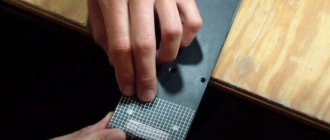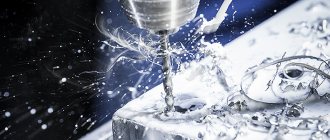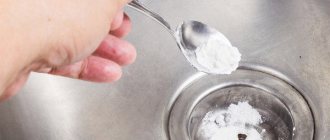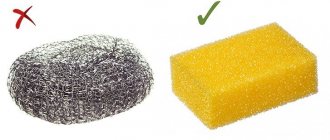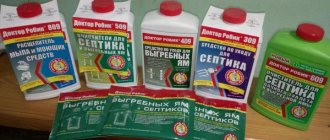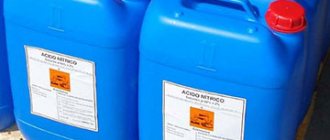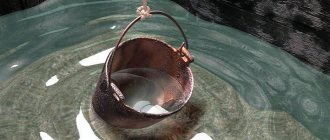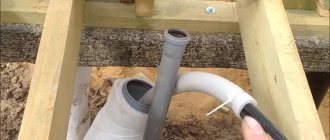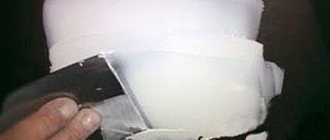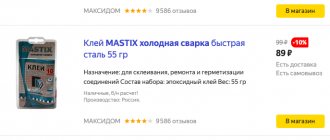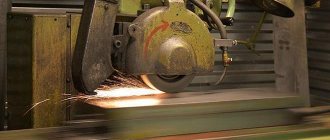Why do you need to degrease?
The dust layer and dirty fatty films on the surface of the material prevent molecules of adhesive or paint from penetrating into the pores of the material. Paint or glue, instead of the surface of the material, connects with the molecules of the fatty layer. This significantly reduces the strength of the joint or the quality of the paintwork.
During welding, fat molecules turn into slag and reduce the quality of the weld until defects form in the welding joint.
To prevent this from happening, it is necessary to degrease the surface before starting the next operation. Degreasing is a mandatory requirement of any technology associated with gluing, painting or cooking surfaces.
Degreasing metal before painting a car
This is necessary for any materials:
- metal;
- glass;
- plastic;
- wood;
- leather;
- ceramics.
A wide range of substances and methods are used to remove grease stains.
Degreasing surfaces before gluing
The modern method of attaching some elements is done using glue of various consistencies, and so on. However, before this, it is necessary to carefully prepare the coating for better adhesion of substances and to extend the service life.
How to degrease the surface before gluing depends on the elements required for the connection. The composition of the glue itself is also taken into account here. First, debris should be removed from the surface. Subsequently, they will prevent the components from fitting more tightly to each other.
At home, metal surfaces are cleaned mechanically. In production, the method of ionization and etching is used.
After mechanical cleaning of the surface, it is washed with water, allowed to dry and only then degreased using solvents, alcohol-containing products, acetone, white spirit, and so on.
Afterwards, you need to check the result by wetting. A drop of water is left on the surface and its “behavior” is observed. If it spreads, then the surface is degreased. If the drop has a rounded outline, then the surface needs additional degreasing.
At home, metal surfaces are cleaned mechanically.
Organic materials (wood, leather, rubber) accumulate many different contaminants that penetrate deep into the pores of the material. To degrease them, only chemicals (acetone, solvents) are used.
Inorganic materials are less demanding when choosing cleaners. Degreasing is carried out according to the standard scheme. However, one point must be taken into account. The moisture contained in the solvents must evaporate well, especially for concrete and ceramic products.
Organic materials (wood, leather, rubber) accumulate many different contaminants that penetrate deep into the pores of the material.
The degreasing process is important. They guarantee the durability of further paint and varnish coating and prolong the operation of glued parts. Despite the positive reviews and versatility of many degreasers, you should initially try them on an inconspicuous and small area.
Working with degreasers
To degrease the part, special solvents are used. Most of them are fire hazards and have high chemical activity and, if handled incorrectly, can cause serious harm to health or damage material assets. To prevent this from happening, you must follow the following safety rules:
- Work in a room equipped with exhaust ventilation.
- Provide good lighting to the work area.
- It is strictly forbidden to use open fire within 5 meters of the work site. Of course, this also applies to smoking.
- Be sure to use personal protective equipment: rubber gloves, safety glasses or a transparent protective shield, a respirator, thick clothing, a hat and shoes that do not leave exposed skin.
- It is also recommended to use an apron made of thick canvas.
- Particular care must be taken when working with aluminum surfaces - in combination with some degreasers, fire and even explosion are possible.
The surface should be treated as follows:
- Apply the degreasing solution with a lint-free cloth.
- A second napkin of the same type is used to wipe and dry the surface.
- The procedure is carried out immediately after mechanical treatment of the surface, immediately before painting or gluing, so that it does not have time to become contaminated again.
- After the operation is completed, do not touch the degreased surface with your hands or other objects.
To check the quality of the operation performed, attach a piece of white paper to the surface. If dirt remains, it will be visible on the paper.
Another way to check is to drop water on the surface. On a well-treated surface, the water will spread out like a film; on a dirty surface, it will form a ball.
Summary
When answering the question of how to degrease the surface of a car, you should take into account some parameters - the effectiveness of the product, its price and efficiency. The ideal option is one that satisfies all these requirements, but it is very difficult to find something similar on sale. In addition to all these factors, it is necessary to take into account the harm that the product will have on the metal or on human health. Therefore, it is necessary to obtain maximum information about the drug. It will not be superfluous to purchase protective equipment for the respiratory tract - masks and respirators.
Any surface must be degreased before painting or carrying out other repair work. Degreasing refers to the process of removing any contaminants - dust, glue, grease, emulsions, old paint residues, and ordinary dirt. Methods and means for degreasing a surface are varied, most of them are easy to use at home.
Chemical methods
The most common and easiest to use are chemical methods for degreasing surfaces.
Most often, organic solvents are used to degrease the surface. They are especially popular among home craftsmen and small workshops. Large industries try to avoid this class of products due to their high fire hazard and toxicity.
The principle of operation of organic solvents is to dissolve the contaminated layer and then remove it from the surface with a dry cloth.
Organic solvent
The effectiveness of such products directly depends on the degree of contamination of the solvent itself - a certain volume of it can also dissolve a strictly defined amount of fatty contaminants. After reaching a certain level of contamination, the solvent is no longer able to degrease the part. Therefore, it is necessary to change wipes more often and moisten them with fresh solvent.
Organic solvents can degrease with high efficiency, but have one drawback. They cannot remove mechanical impurities, abrasive residues, etc. from the surface.
What is defatting
The essence of the procedure is to remove fatty substances from the surface of the substrate, which are often present in cooling emulsions, mineral oils, preservative lubricants, and polishing compounds. Degreasing of the metal surface before painting also has to be done to remove residues from washing and etching, traces of sweat and fingers. All these contaminants can extremely negatively affect the quality of surface wetting with paints and varnishes, as well as harm film formation and other properties of the coating.
Depending on the amount of fatty impurities present per square meter, several degrees of surface contamination can be distinguished:
- Weak - up to 1 g;
- Medium - from 1 to 5 g;
- Increased - more than 5 g.
When processing fats with chemical reagents, several sequential processes occur on the surface:
Depending on the ability of fats to be destroyed under the influence of solvents, several types of contaminants are distinguished:
- Non-destructible - for example, emulsions.
- Pollinated - polishing materials, lubricant residues.
Chemical methods
The main type is organic solvents, which allow you to quickly remove grease and oily areas from metal parts. They are most widely used in individual production, although sometimes they are used in serial production, but not often due to their high explosion and fire hazard. The desired effect, namely the dissolution of oil and fat deposits, is achieved at the moment of contact of organic solvents with them.
The quality of surface degreasing is directly affected by the degree of solvent contamination, since the more fats are contained on the surface, the worse the chemical’s ability to dissolve existing deposits becomes. Most often, aliphatic and chlorinated solvents are used to remove fat and oil areas. Despite their high efficiency in metal cleaning, they have a serious drawback - these compounds are not able to remove abrasive materials and other mineral contaminants from the surface.
Aqueous solutions
As is known, water has poor purification ability, which is associated with significant surface tension and incompatibility with fats. Therefore, when it wets greasy surfaces, stable emulsions are not formed. To increase the cleaning properties of an aqueous solution, manufacturers resort to various techniques - increasing the pH acidity level, increasing the temperature regime of use to the range of 50-65 degrees Celsius, and introducing surfactants into the composition.
Alkaline degreasers
These compounds have a lot of positive properties. These include high cleaning ability, fire safety, environmental friendliness, and a wide selection of application methods. When treated with aqueous solutions of saponified fats and oils, the latter are inevitably destroyed, and unsaponifiable contaminants are emulsified. The latter case can be described as the process of detachment of fatty layers from the surface with gradual transformation into a working liquid and removal along with the working solution. The main disadvantage of these compositions is the need for anti-corrosion treatment of the surface after cleaning.
Among the components present in cleaning solutions, surfactants - surfactants - deal best with fatty and oily areas. Once on the surface, they form foam on it, simultaneously reducing interfacial and surface tension, increasing wettability and destroying solid and liquid contaminants, transforming them into a more convenient form for removal. The surfactant content in grease cleaners , as a rule, fluctuates within 10%.
If the need arises, along with degreasing, to remove thin oxide or hydroxide films, acidic solutions containing 1-3% phosphoric acid are used.
After treating surfaces with cleaning compounds, they must be washed with water. The presence of salt residues is unacceptable, since they can destroy the properties of paint films, increasing moisture permeability and accelerating the development of under-film corrosion.
Emulsion compositions
In cases where there is a need to remove oil deposits, grease, and difficult-to-remove contaminants from the surface, emulsion degreasing is used. This method is combined and has the advantages of organic solvents and aqueous alkaline solutions. These compositions contain emulsions of solvents and surfactants diluted with water. Chlorinated or aliphatic hydrocarbons can be used as solvents.
Ultrasonic and electrochemical methods
To increase the cleaning ability of detergent compositions, special baths with an ultrasonic field are used. This method is most relevant for small-sized products with a highly complex surface, for which it is important to remove contaminants with the highest quality possible. For large parts, it is not practical to use this method due to economic considerations, since there is a need to increase the output power of the device.
Aqueous solutions
Water itself is not an ideal liquid for degreasing surfaces - just remember attempts to wash greasy dishes with cold water. This is due to its high surface tension and its inability to emulsify fats.
To make surface degreasing with aqueous solutions effective, the following methods are used:
- increase pH acidity level;
- heat the solution to 55-60 oC;
- add surfactants (surfactants).
Water based degreaser
Aqueous solutions are quite effective against light and medium levels of contamination. They are significantly less dangerous to use than organic solvents.
Why do you need to degrease the surface before finishing?
Any exterior that comes into contact with dust particles or has been used has a lot of invisible contaminants.
The minimum degree of contamination is one gram per meter. If the value is over five grams, then this is a strong degree of contamination.
If you do not degrease the surface, then subsequent repair work will significantly decrease in quality, which will affect the short service life of the product or object. All types of surfaces are subject to the cleaning process.
If you do not degrease the surface, subsequent repair work will significantly decrease in quality.
Alkaline degreasers
Alkali-based degreasing solutions are characterized by a number of advantages:
- high efficiency, including against high levels of pollution;
- low harmfulness;
- no fire hazard;
- environmental friendliness;
- various methods of application to the surface.
During interaction with alkaline solutions, saponified fatty compounds are destroyed. Unsaponifiables form an emulsion and are removed along with it. A significant disadvantage of alkaline solutions is that after treatment they must be protected against corrosion.
Surface-active substances very effectively dissolve fatty contaminants. When it comes into contact with dirty areas, foam is formed, which reduces surface tension and the adhesion force of molecules to each other. Contaminants in solid and liquid form are destroyed and turn into solutions and emulsions, which are then easy to remove. Surface degreasing products contain up to 10% surfactants.
If, in addition to fatty contaminants, it is also necessary to remove thin films of oxides from the surface, then weakly concentrated acid solutions are used. This treatment is carried out, for example, before welding non-ferrous metals and their alloys.
Alkaline cleaner for removing combined stains
Surfaces treated with degreasers must be washed with water. If salt deposits are left, they can damage the paintwork by increasing its moisture permeability and reducing corrosion protection.
Degreasing agents
If a person decides to paint a surface in a house, apartment, or country house, any suitable product is used for degreasing, which is applied to a lint-free microfiber cloth or other suitable material.
This method is not suitable if preparation for painting the car body is required. Of course, it is better to entrust the cleaning and painting of a car to a professional who will do the job efficiently. In some cases, you can remove the grease film and protect the car body from corrosion with your own hands.
We recommend: Ways to reduce the intensity and rate of corrosion of metal products
White Spirit
Almost every car enthusiast has the organic solvent White Spirit, and repair shops use it regularly. White spirit is intended for the initial treatment of the body, after which it is practiced to apply alcohol mixed with orthophosphoric acid to remove residual contamination. The solution is prepared by combining substances in a certain proportion.
Using white spirit you can safely clean car parts; the composition will not harm the metal surface. Low cost is another plus. The downside is the strong smell. Some car owners replace the solvent with trichlorethylene, but it should not be used on aluminum alloys - there is a risk of fire.
Gasoline, acetone, other analogues
All of these products are good solvents for grease, mastic, and paint. Diesel and kerosene have a rather dense structure and are difficult to clean, but their composition is suitable for degreasing.
After using kerosene, gasoline, or solvent, you will have to use an enhanced wash to remove all traces. It is undesirable to use acetone for treating cars - some types of it can cause harm to the metal.
Antisilicone
Antisilicone is a colorless liquid, a remover for removing silicone, grease, and oil. This substance is intended to remove contaminants from steel, aluminum, stainless steel, plastic, galvanization, and varnish coatings.
It is applied to the surface, then wiped with a dry cloth or paper towel. You need to wear a mask and gloves when working, and the room must be ventilated.
Antistatic
The surface can be degreased before painting using an antistatic agent. It is especially effective to do this on plastic, which attracts dust due to its ability to become electrified. It will be difficult to remove the grease film, but after treating the surface with an antistatic agent it will be much easier.
Alkalis
The preparations in this group contain detergent chemicals with an alkaline effect. They can wash away any contaminants, including grease. Usually used in everyday life.
To clean plastic and concrete, a roller is used for application. Before painting a car, use alkalis with great care, then rinse the surface thoroughly with water and dry the parts. Do not apply large amounts of product or create strong foam.
Ultrasound and other methods
A new method of surface cleaning is the use of solutions coupled with baths with an ultrasonic field. The method is suitable for degreasing small parts whose surface is uneven, has complex curves and includes various mechanisms (for example, watches). Due to the high cost, the method is not suitable for large products.
There is a method of electrochemical degreasing. It is also carried out in baths where gas is supplied from electrodes.
Surfaces are cleaned with chemical solutions using current. Typically, such processing is used in production and industry.
Emulsion compositions
If it is necessary to remove stains of grease, oil deposits, or other particularly dense contaminants, use a metal degreaser that works by emulsification. The composition is combined. It contains emulsions of organic solvents, aqueous alkaline solutions and surfactants, combining their strengths. Acting together, the components of the composition are able to cope with the most persistent stains. The concentration of hazardous substances in it is reduced, so it can be used at home.
Multi-step cleaning
The first step is to treat the body with white spirit. What to do if there are traces of corrosion on the surface? In this case, it is necessary to treat the surface using phosphoric acid with alcohols. This composition is a mixture of ethyl alcohol in a ratio of 15%. Part of the water and phosphoric acid is also mixed in a ratio of 1 to 5. Additionally, an emulsifier is used - wetting agent OP-7 in an amount of 0.5%. 0.1% nitrobenzene is also required. It is quite difficult to obtain this mixture at home - some substances are not commercially available. It is also worth remembering that the composition is hazardous to health.
Ultrasonic and electrochemical methods
In addition to chemical exposure, ultrasonic cleaning is also used in industrial settings. Small-sized parts of complex configuration, with intricate relief and internal cavities, are immersed in a bath filled with a cleaning agent. Vibrations at an ultrasonic frequency (20-150 kHz) are excited in the bath. These vibrations not only destroy the fat layer, but also enhance the effect of the active components of the cleansing solution. For large-sized products, this method is rarely used, since they require very high power of the oscillator and the operation becomes ineffective from an economic point of view.
Another method of enhancing the impact of cleaning compounds is electrochemical. It also uses baths of dielectric material filled with solution. The part to be cleaned and another metal electrode are lowered into the bath and an electric current is passed through them. Due to the electrochemical reaction, gas bubbles are abundantly formed on the parts - the electrode; their collapse reduces the density of contaminants and enhances the chemical activity of the components of the composition. By using this method, it is possible to increase processing efficiency and reduce solution consumption.
Review of popular manufacturers
Today there is a huge selection of products for degreasing metal before painting. Manufacturers have long established themselves in the consumer market. In specialized stores, sales consultants can offer a choice of one of the following solutions:
- White spirit is the most popular degreaser. It has a specific odor of fuel and lubricants and is a transparent liquid. Containers of various sizes are available;
- Solvent 646 is a yellowish liquid with a pungent odor. Used for degreasing any surfaces, removing layers of paint, cleaning construction equipment and tools. The degreaser is also used to thin enamels;
- Acetone is a clear liquid with a specific odor. Eliminates various types of stains (tar, grease, oil). Can be used to dilute varnishes and paints;
- Solvent is a clear or yellowish liquid. It is used not only as a metal degreaser, but also as a paint thinner. Widely used when working with cars;
- Kerosene is the most inexpensive degreaser. Successfully used to remove stains from leather and fabric products.
Attention: Before starting to work with degreasers, you should carefully read the instructions and follow safety precautions.
Organic degreasers
Organic degreasers quickly and efficiently remove greasy stains from metal. Despite the effectiveness of use, the substances have a high fire hazard, which in turn limits the range of use. Such means are used more by private individuals, less often in production.
They have organic solvents and disadvantages, such as:
- high material consumption due to the high volatility of the substance;
- removal of only particles of greasy dirt. The degreaser practically does not come into contact with solid particles and abrasive materials.
Emulsion cleaning compounds
You can remove greasy stains from surfaces using emulsion degreasers. Widely used to remove carbon deposits, grease, and old paint. Before starting work, be sure to wear special gloves to prevent the substance from getting on the epidermis.
Emulsion solvents are often used in everyday life. The main components of a degreaser are a solvent, an emulsifier, water, and detergent additives.
Alkaline and acidic agents
Alkaline and acidic degreasers are excellent at cleaning surfaces. Special surfactants included in alkaline products effectively combat both liquid and solid types of contaminants.
The advantages of solutions of this type include environmental friendliness and fire safety. In addition, degreasers can be applied to metal in a variety of ways.
Important to know: After using alkaline or acidic degreasers, the metal area or product must be thoroughly washed with plain water to remove solvent residues.
How to degrease metal before painting
Common home remedies for degreasing metal before painting are time-tested reagents:
- kerosene;
- White Spirit;
- acetone;
- alcohol.
The modern market offers more advanced and effective compositions for degreasing various materials. The composition “Nefas” based on white spirit has gained great popularity. Licensed solvents, such as Solvent 646, are also widely used at home and in small workshops. They differ from the “old-fashioned” formulations in their availability, greater environmental friendliness and less harm to health.
How else can you degrease the metal surface?
Another popular group of metal degreasing compounds is collectively called Antisilicone. They are popular among auto body shop owners in preparation for painting car body parts. It is worth remembering that these compounds are flammable, so you need to ensure high-quality ventilation of the room and under no circumstances use open flames or smoke while working with them. Personal protective equipment is also required - a respirator, protective gloves and goggles.
Such compounds as “Chistomet” and its imported analogue Docker Dekamet deservedly enjoy the reputation of being one of the most effective products. Their main component is an alkaline solution. In addition, they include:
- corrosion inhibitors;
- Surfactants;
- additives that enhance the effect of the composition.
The substances are supplied in the form of a concentrate; before degreasing the part, it must be diluted with water. The dilution proportion is selected depending on the degree and persistence of contamination.
Metal degreaser
The main advantage of these products is their high environmental friendliness and reduced health hazard. Particular care should be taken only with concentrate. In addition, the product can also be used not only for degreasing metal surfaces, but also for their anti-corrosion treatment.
What means exist
Often, to combat the greasy film that is on the body, car enthusiasts use lint-free wipes treated with some kind of solvent in the old fashioned way. Experts do not recommend performing this procedure in this way. This option is suitable only when it is necessary to process only a small area. If you look at the range of preparations for preparatory work before painting that are produced today, you can highlight several products that degrease metal surfaces. These are various solvents and substances of organic origin, emulsions, as well as special solutions that contain synthetic detergent additives.
Popular solvents
Many home craftsmen and car owners who repair their cars themselves are wondering how to degrease parts before painting. In addition to time-tested products, more effective formulations are available today.
White spirit
White spirit enjoys well-deserved popularity. It is a clear, uncolored liquid with a strong odor typical of petroleum products. One of the commercial names under which it is presented on the market is “Nefas C4”.
It is universal in use and is highly effective. It is capable of degreasing any grease and fatty compounds, as well as many organic substances. Excellent for thinning most oil-based paints. Therefore, after applying it to the part, you do not need to wait for it to dry completely, but you can immediately begin applying primer or paint. The product differs from other formulations in its high evaporation rate. When using white spirit, it is also necessary to thoroughly ventilate the room and use personal protective equipment.
Solvent 646
This composition has a yellowish tint and a pungent odor. It was originally positioned as a paint thinner, but is also successfully used to degrease metal parts. Excellent for removing old layers of paint from parts, for washing brushes, rollers and other painting equipment.
The best compatibility is achieved with the following types of paints:
- based on nitrocellulose (labeling NC);
- glypthal (GF);
- based on epoxy resins
- acrylic;
- melaninoamide (MP);
Solvent 646
The composition has certain restrictions on the conditions of use. It can best degrease when:
- temperature +5 - +30 °C;
- relative air humidity less than 85%.
In this case, the metal acquires shine and gloss and no rainbow stains remain.
When working with this effective and popular product, it is worth remembering that it is flammable and harmful to health. Personal protective equipment is required: gloves, goggles, respirator. It is strictly prohibited to use open fire, including smoking, within 5 meters of the work site. The room must be well ventilated or equipped with exhaust ventilation.
Acetone - classic
Acetone is one of the classic, decades-tested means for removing oil and grease stains and deposits. It is a volatile, transparent, colorless liquid with a sharp, characteristic odor. Acetone can degrease vegetable, animal and mineral oils and resins.
The substance is widely used for diluting paints and varnishes. It is used both in pure form and as part of other solvents, for example, together with alcohol.
Acetone
Due to the exceptional volatility of the liquid, when working with acetone, it is necessary to carefully observe safety precautions - do not use open flames, do not smoke, use safety glasses and gloves, and a respirator. You should not bend over a container with acetone - involuntary inhalation can cause dizziness and even loss of consciousness.
Degreasing technology
The degree, form and parameters of pollution can be random or systematic. The first refers to contamination that appears as a result of repairs or during scientific research. Pollution from industrial production is systematic.
The degree, form and parameters of pollution can be random or systematic.
How to treat metal before painting
Degreasing the material before painting is necessary for better adhesion of the new layer of paint to the surface, as well as the immediate subsequent protection of the material from oxidation.
Initially, car owners used the well-known acetone, gasoline, alcohol and kerosene for the process. Now white spirit has been added to this list. A common mistake that owners make is choosing a product that does not match the subsequent paint. Solvent marked 646 eliminates the mistaken choice. Judging by the reviews, this is a universal remedy. It is ideal when you need to remove old paint.
Solvent marked 646 is ideal when you need to remove old paint.
The use of anti-silicone has also found its niche of popularity. However, when performing preparatory work, it is important to follow safety rules. Degreasing is carried out in a well-ventilated area, away from sources of fire.
Substances containing alkali, which is the active component, are considered effective. Inhibitors, additives and other additives are auxiliary. Alkaline products are sold in the form of a concentrate, which should be diluted with water in the proportions recommended by the manufacturer before use. Their main advantage is safety and lack of toxicity.
To do this, use acetone, gasoline and white spirit. If there is rust on the surface or old paint that is difficult to remove, then first the stains are treated with a grinding machine or sandpaper. For large areas it is better to use electrical appliances.
Further finishing work is carried out only after complete evaporation of the solvent on the surface. Those elements that do not need to be painted are insulated with double-sided tape.
If there is rust on the surface or old paint that is difficult to remove, then first the stains are treated with a grinding machine or sandpaper.
How to degrease plastic
Plastic has a low coefficient of adhesion to other materials, so plastic products should be processed. How to degrease plastic before painting? Before using any product, even a suitable one, you need to test it on a small area. What liquids are suitable:
- White Spirit;
- Any alcohol or product containing alcohol;
- Solvent 646. However, knowledgeable people do not recommend using it, despite its versatility. The solvent removes the topmost polymer layer from the products.
If there are concerns about the strong effects of the products, it is allowed to dilute them with water. The plastic surface is cleaned with a soft cloth pre-moistened in the solution. However, first you should wipe off all the dust with a dry cloth.
However, the above remedies are the answer to the question of how to degrease plastic for household use. All these drugs can be classified as products containing aggressive components. For automotive plastic, it is better to give preference to a softer agent, for example, anti-silicone.
When using strong products, it is not recommended to apply much pressure to the surface. Carry out all work wearing a mask and gloves. Before subsequent processing (gluing, painting), the liquid from the surface must completely evaporate.
Before using any product, even a suitable one, you need to test it on a small area.
Glass degreasers
Unlike polymer materials, glass reacts more tolerantly to contact with aggressive environments.
To prepare glass before gluing, use universal or alcohol-containing products. In order to simply wash glass, it is better to use highly targeted materials.
To wash glass, including car glass, use regular window and mirror detergents. However, in order to also degrease the surface, you can purchase a specialized two-in-one product in a tube, which is sold at any auto parts store.
If car windows have not been cleaned for a long time, then universal white spirit will come to the rescue. However, it is not recommended to use it in its pure form, only diluted with water.
To prepare glass before gluing, use universal or alcohol-containing products.
Sandblasting
Before using certain compounds to degrease the part, it is subjected to mechanical processing. This allows you to remove mechanical impurities, rust, and partially old paint and varnish coatings and facilitates the work of the degreaser.
To do this, use sandpaper or abrasive wheels driven into rotation by an angle grinder. This method is good for small parts. If you need to prepare a large part for painting, sandblasting comes into play.
High-pressure air passing through the nozzle carries along the sifted grains of sand, they hit the surface with force and act as an abrasive material. The flow of sand grains removes all mechanical impurities, rust and old paint from the part. The surface remains rough, which improves its adhesion to glue or paint. In addition to metal, sandblasting is used for hard plastics, wood and stone.
Sandblasting
After sandblasting, the part must be washed with clean water under pressure to wash away any remaining sand and dust and dried with compressed air. Now you can start degreasing.
After the surfaces have been cleaned before gluing, they are washed in clean water to remove small particles, dried thoroughly and degreasing begins.
Errors while performing work
An important point is compliance with safety precautions. They cannot be ignored. Few people perform degreasing outdoors - if the operation is carried out in a garage, under a roof, its effectiveness increases. And working in a confined space is unsafe. Most degreaser compounds are flammable. Their vapors are harmful to the human respiratory system and sometimes to the skin. Therefore, perform degreasing in a room with good exhaust ventilation. It is important to protect your eyes, respiratory system and skin.
How to degrease plastic
Difficulties arise when processing plastic. If metals are not dissolved by cleaning products, then in the case of plastics, the solvent can dissolve the part itself. This may cause blistering, delamination, or complete destruction of the plastic. Some plastics are dissolved with acetone, others with gasoline, and others with benzenes or dichloroethanes. There is no universal degreaser for plastics.
How to degrease plastic without destroying it?
A number of plastics are resistant to white spirit and can be used. But first it’s better to test it by dropping a small drop onto the part in an inconspicuous place.
For automotive plastics, they produce a mild composition “Piton” and a more powerful APP WK900. They are also combined with rubber products.
Degreaser for plastics
Another option for safely cleaning plastic from oil and fat contaminants is antistatic solutions. They not only remove static charge, after which the plastic stops attracting dust and dirt, but also allow you to gently remove fat deposits.
Ethyl alcohol or just vodka is also suitable for degreasing plastics (cognac or rum tinctures and liqueurs are not suitable due to the sugar content and flavoring additives)
Degreasing metal
In addition to grease and dirt, metal often contains rust, paint, and sealant residues. For metal processing you should choose white spirit, acetone, gasoline.
The procedure is as follows:
- Remove rust, paint, sealing residues with a grinder, manually, grinder, sandpaper - in any convenient way (the bathtub in the house is treated with a sponge and soda). It is better to clean large areas with a power tool.
- Moisten a cloth with solvent and treat the product until completely clean. If the parts are small, you can simply immerse them in solvent.
- After complete drying, you can apply primers and paints. Those areas that cannot be painted should be covered with double-sided tape.
Wood products
Before processing wood, it must be cleaned with a wire brush, sandpaper or a flexible abrasive wheel. The most deeply ingrained dirt will have to be planed off with a plane or a layer of wood removed with a ring sander.
General purpose organic solvent compounds are excellent for degreasing wood.
It is preferable to use a paint roller for application.
Gasoline rarely copes with cleaning wood; it should not be used.
Glass degreasers
Compared to plastics, glass practically does not react to any solvents except the strongest acids. Therefore, you can use any available composition for it. It is important to remember that the properties of glass do not apply to rubber seals - rubber or plastic frames. They will have to be dismantled or protected from the effects of the solvent composition.
Degreasing glass
To degrease the glass surface, use alcohol, acetone, license solvents, alkaline solutions, white spirit - whatever is at hand.
Which degreasers do car enthusiasts choose (reviews)
There are different opinions on how to choose a degreaser for a car, the price and quality of which will be commensurate.
“I wanted to clean the body of my foreign car. I couldn’t find a special product in a nearby store, but the seller suggested Peresvet degreaser and convinced me that it works the same way.
I was lucky that I was distracted by family matters and delayed processing for a few days. Then I compared the products, and it turned out that the degreaser that I bought (that is, “Peresvet”) has the same composition as “Galosha” gasoline (Nefras-S2-80/120). And most importantly, it can damage the surface of your car!”
“Everyone knows that white spirit combines aromatic and aliphatic hydrocarbons in some ratio. Each manufacturer has its own formula and, of course, different requirements for the purity of its composition. The same hydrocarbons are included in almost all protective coatings. Now draw your conclusion.
I think that white spirit alone as a car degreaser is, of course, not enough. In particular, if you buy cheap, poisonous-smelling Nefras or a dubious liquid called White Spirit. I think it’s still necessary to add an alcohol-based “degreaser.”
“In summer, a degreaser helps remove traces of poplar. I personally used this composition only once. But in winter I use it all the time, otherwise I can’t wash my car.”
Remedies before gluing
Before gluing parts, it is imperative to treat their surfaces to remove oil and fat contaminants and increase adhesion. Even if the surface looks clean, it should still be degreased, since a thin film of fat is not visible to the naked eye.
The choice of composition will be determined by the materials being bonded. For metal, plastic and glass, the same solutions are suitable as when preparing for painting.
For rubber, it is recommended to use isopropyl alcohol or products based on it. The degreaser solution must be applied to a dry surface. When mixed with water, many solutions lose their effectiveness.
When gluing plastics, you should definitely try the product in an inconspicuous place or on a small piece of the same plastic.
A drop of water applied to the surface can be used to check the quality of degreasing. If it spreads freely in a thin layer, it means that the cleaning was carried out efficiently.
How to degrease a car body with your own hands
Before starting degreasing with your own hands, you should thoroughly wash the car so that no:
- palm and fingerprints;
- dust;
- other dirt;
- sand and other contaminants that can act as abrasive particles.
The latter is especially important, otherwise, as soon as you start rubbing the car body, there is a danger of serious damage to the paintwork. First, you should clean the car using a high-pressure washer (for example, a Karcher). The next stage is traditional hand washing using classic detergents.
For further work, prepare:
- face protection – respirator, construction glasses;
- rubber, latex, silicone or other gloves;
- lint-free wipes to check the quality of work.
The selected degreaser is applied to the car body. You can use a spray bottle or cloth. The composition must be carefully distributed over the entire surface.
Note! If fabric is used, it should be lint-free and dense. Change contaminated rags as they become dirty. This is a mandatory condition, otherwise fatty deposits will not be removed, simply spreading over the surface.
The entire car needs to be treated, including plastic and glass parts. In the lower part of the body (40-50 cm strip), 1.5-2 times more degreaser must be applied. The composition remains on the surface for 5 minutes. Then it needs to be washed off with clean water or car shampoo.
The next step is checking the quality of work. A lint-free cloth is passed over the already treated surface. If there are no streaks left on the body and no dirty spots on the napkin, degreasing has been carried out correctly.
After the operation, do not touch the machine with your hands, clothes or rags. It is necessary to immediately begin the following procedure: painting, puttying, polishing, applying stickers, and intensive washing. They will be successful if the process of removing fat deposits was carried out in compliance with all the rules.
If the next step is professional washing or polishing, carelessly performed degreasing will not have fatal consequences. But problems are inevitable if mistakes are made in the process of preparing for repainting.
